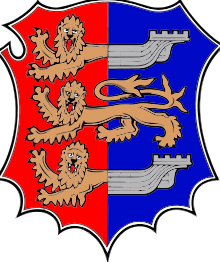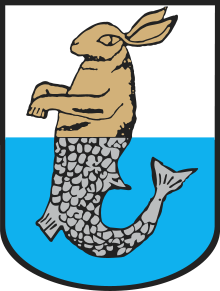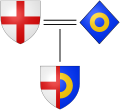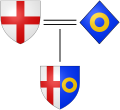- Dimidiation
-
This article is about heraldry. For the mathematical operation, see division by two.
 Coat of arms of Hastings, showing a partially dimidiated shield, where the front halves of the upper and lower lions are joined to the rear halves of ships. This motif features widely in the heraldry of the Cinque Ports
Coat of arms of Hastings, showing a partially dimidiated shield, where the front halves of the upper and lower lions are joined to the rear halves of ships. This motif features widely in the heraldry of the Cinque Ports
 Horizontally dimidiated rabbit and fish, arms of the town and gmina of Prochowice, SW Poland. Horizontal dimidiations are rare, if not unknown, in English heraldry
Horizontally dimidiated rabbit and fish, arms of the town and gmina of Prochowice, SW Poland. Horizontal dimidiations are rare, if not unknown, in English heraldry
In heraldry, dimidiation is a method of joining two coats of arms.
For a time, dimidiation preceded the method known as impalement. Whereas impalement involves placing the whole of both coats of arms side by side in the same shield, dimidiation involves placing the dexter half of one coat of arms alongside the sinister half of the other. In the case of marriage, the dexter half of the husband's arms would be placed alongside the sinister half of the wife's arms. The practice fell out of use because the result was not always aesthetically pleasing (sometimes creating strange hybrids, as seen in the examples at right), and also because in some cases, it would result in a shield that confusingly looked like one coat of arms rather than a combination of two. For instance, a bend combined with a bend sinister might result in a combination that simply looked like a chevron, thus hiding the fact that two coats of arms had been combined. In order to avoid these drawbacks, it became customary to use more than half of each coat of arms when combining them through dimidiation. Once this practice had begun, the logical progression was to include the whole of both coats of arms in the new shield, so that in effect, impalement replaced dimidiation as a method of combining coats of arms. One rule which carries over from dimidiation to impalement is that if a coat of arms with a bordure is impaled, the bordure does not continue down the line of impalement, but is cut short.
See also
- Division of the field
- Frisian eagle
Sources
- Arthur Charles Fox-Davies, A Complete Guide to Heraldry (1909), pp. 182, 523-525. Online texts at http://www.archive.org/details/completeguidetoh00foxduoft or http://www7b.biglobe.ne.jp/~bprince/hr/foxdavies/index.htm .
References
Categories:
Wikimedia Foundation. 2010.



